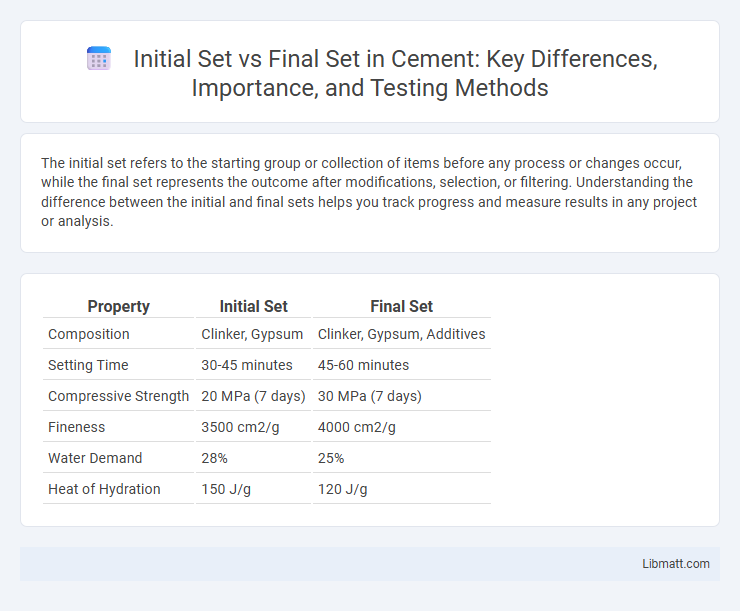The initial set refers to the starting group or collection of items before any process or changes occur, while the final set represents the outcome after modifications, selection, or filtering. Understanding the difference between the initial and final sets helps you track progress and measure results in any project or analysis.
Table of Comparison
| Property | Initial Set | Final Set |
|---|---|---|
| Composition | Clinker, Gypsum | Clinker, Gypsum, Additives |
| Setting Time | 30-45 minutes | 45-60 minutes |
| Compressive Strength | 20 MPa (7 days) | 30 MPa (7 days) |
| Fineness | 3500 cm2/g | 4000 cm2/g |
| Water Demand | 28% | 25% |
| Heat of Hydration | 150 J/g | 120 J/g |
Introduction to Initial Set and Final Set
Initial sets represent the starting collection of elements or conditions before any transformation or processing occurs, serving as the input for analysis or operations in mathematics, computer science, and data science. Final sets denote the resulting collection after applying specific functions, algorithms, or procedures, reflecting the outcome or solution state. Understanding the relationship between initial and final sets is crucial for evaluating the effectiveness and correctness of processes in various computational and mathematical contexts.
Defining Initial Set: Meaning and Importance
The initial set refers to the original group of elements or data points selected at the beginning of a process or study, serving as the foundational input for analysis or experimentation. Its importance lies in establishing the baseline conditions that influence the accuracy, relevance, and validity of subsequent results. Proper definition and selection of the initial set are crucial for ensuring meaningful comparisons and effective tracking of changes in the final set.
Understanding the Final Set Concept
The Final Set concept represents the collection of states or outcomes after a process or transformation completes, differing from the Initial Set, which contains the starting points or conditions. Understanding the Final Set is crucial for analyzing the end results of algorithms, systems, or experiments, as it reveals what has been achieved or concluded from the initial parameters. You can optimize processes by comparing the Initial Set with the Final Set to identify changes, efficiencies, or errors throughout the operation.
Key Differences Between Initial and Final Sets
Initial sets represent the starting collection of elements or data points before any changes or processes occur, commonly used in experimental designs or mathematical functions. Final sets denote the resulting collection after transformations, filtering, or operations have been applied, reflecting the outcome or end state. Key differences include the timing of observation--initial sets mark the baseline conditions, while final sets provide data for analysis post-intervention, often showing reduced or altered elements.
Applications of Initial and Final Sets
Initial sets are crucial in automata theory for defining the starting states from which computations or processes begin, enabling accurate modeling of systems in fields like language parsing and sequential circuit design. Final sets determine the accepting states that signify successful completion or recognition of specific inputs, essential for validating strings in regular expressions and formal language recognition. Both initial and final sets find applications in designing finite state machines, compiler construction, pattern matching algorithms, and verification of software and hardware systems.
Benefits of Identifying Initial and Final Sets
Identifying the initial set and final set in system analysis optimizes state transition mapping, ensuring accurate modeling of system behavior. Recognizing these sets enhances error detection and simplifies debugging by clearly defining entry and exit points in processes. You gain improved control flow understanding and efficient resource allocation by pinpointing initial and final states early in design.
Common Mistakes in Distinguishing Initial vs Final Sets
Confusing initial sets with final sets often leads to misinterpretation of data boundaries, as initial sets represent starting conditions, while final sets indicate end results or steady states. A common mistake is assuming that elements present in the initial set should always appear in the final set, disregarding possible changes during a process. Understanding your system dynamics accurately requires careful distinction between these sets to avoid flawed conclusions.
Practical Examples of Initial and Final Sets
Initial sets represent the starting points or inputs in mathematical functions, such as the domain in a function f(x) = x^2 where the initial set could be {1, 2, 3}. Final sets correspond to the outcomes or outputs, like the range of the function where f({1, 2, 3}) = {1, 4, 9}. In practical scenarios, inventory management tracks initial stock as the initial set and sales leading to remaining inventory as the final set, illustrating the transition from input to result.
Strategies for Transitioning from Initial to Final Set
Transitioning from the initial set to the final set requires a strategic approach that emphasizes gradual progression in intensity and volume to prevent injury while maximizing muscle adaptation. Implementing techniques such as controlled tempo, rest-pause, or adjusting resistance can help optimize strength gains and muscular endurance. Monitoring your form and fatigue levels during this transition ensures effective performance and sustained progress toward fitness goals.
Conclusion: Choosing and Managing Sets Effectively
Choosing between initial set and final set depends on your goal, as the initial set establishes a foundation while the final set represents the refined outcome. Effective management involves continuous evaluation and adjustment to ensure the final set aligns with desired objectives and quality standards. Prioritizing flexibility and accurate criteria during the selection process enhances overall results and efficiency.
Initial set vs Final set Infographic

 libmatt.com
libmatt.com